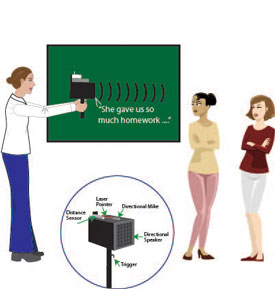Silencing with the Speech Jammer
If “shhhh” doesn’t work, the Speech Jammer might. This device renders chatterers speechless! Who knows, the Speech Jammer may one day find its way into classrooms and debates. This device created by Kazutaka Kurihara and Koji Tsukada won the 2012 Ig Nobel prize in acoustics.1-3
The Speech Jammer
The speech jammer uses our own speaking to silence us. For the average person, speaking requires us to hear ourselves. If that feedback becomes distorted, the person slows down and then stops talking.1-4
The speech jammer records a person’s voice and plays it back with a slight time delay (a few hundred milliseconds).1 This feedback of hearing your words again, slightly after you’ve said them, is so disruptive that it renders you speechless. Perhaps, with practice, one might be able to overcome the speech jammer and continue speaking, but to the best of our knowledge, it hasn’t been done yet. Kurihara and Tsukada have posted a YouTube video of their Speech Jammer in action, which you can see below.4
The speech jammer is composed of a directional microphone, a time delay integrated circuit, and a directional speaker to play the sound back. All of the components are well known, but the novelty stems from how they are used together.
The Physics Behind the Speech Jammer
There are many types of microphones, but they all work on the same principles — transferring sound energy into something different. The first microphones transferred sound energy into mechanical energy, and most modern microphones transfer sound energy into electrical signals.
Sound energy is just a compression wave that travels in a substance such as air. As the sound wave passes through a substance, there are sections where the molecules get bunched up (compressed) and sections where they get spread apart (rarefied). This is similar to a compression wave in a slinky, as shown in the video below.


A sound wave can transfer mechanical energy to an object, changing its position. In turn, this change in position can easily be transformed to a change in electrical signal.
One type of microphone changes the distance between two conducting plates, often containing carbon between them. A small electric current (moving electric charge) flows through the plates. The outer plate acts as a movable membrane or diaphragm that changes location as the sound wave strikes it. The small changes in distance between the two plates alters the electric current in the system, and this produces a varying electrical current encoded with the sound wave’s information.
Another type of microphone utilizes a change in the intensity of a laser beam reflected off of a diaphragm. Some microphones use crystals that change pressure as a sound wave strikes it, causing a change in voltage. Yet another type utilizes the motion of a current carrying coil connected to a diaphragm that vibrates when the sound strikes it. This method is basically a speaker in reverse.
All in all, microphones function because the sound wave strikes an object (usually called the diaphragm) within an electric circuit. The change in location ultimately causes either a change in electric current (motion of charged particle) or voltage (energy per charged particle) within the circuit. This embeds the sound wave’s information in the electrical signal.
A speaker has the reverse function of a microphone — transforming an electrical signal into sound. Also, speakers can be used in reverse as a microphone. A speaker consists of a diaphragm (often made of paper), connected to a rigid support (frame or basket) through a suspension system (spider). Within the suspension system is a coil of thin wire (voice coil) that is free to move up and down along a pole. There is also a permanent magnet housed in the base of the speaker.

A Speaker. Image Credit: Lain via Wikimedia Commons.
When an electric current goes through the coil of wire it produces a magnetic field that interacts with the permanent magnet. As the current changes, the magnetic field it produces changes. This leads to a change in the force between the coil’s produced magnetic field and the permanent magnet, forcing the coil of wire to move up or down. As the coil moves up and down, the diaphragm moves up and down. The diaphragm is what ultimately produces the sound we hear because it produces a pressure wave as it moves.
A time delay is used between the microphone and the speaker to delay the output of the device. The very first time delays used in sound consisted of a looped magnetic recording tape. Today, pre-packaged integrated circuits can be purchased to create the delay in either an analog or digital format. Digital formats are more common, which encode the information with the electrical signal being on or off.
The sound information is recorded and played back from a rewriteable storage system, like flash memory systems. In an electronic circuit, a delay occurs naturally due to the type and size of a wire, but those delays are usually of the order of microseconds and are insignificant in such a small device as this.
Often one will use a resistor and capacitor as a simple time delay circuit. The current will not flow in the circuit until the capacitor has accumulated a certain charge on it, which depends upon the amount of time it takes to charge the capacitor.
The basic physics of the components of the Speech Jammer is understood, but why it affects humans the way it does is not well understood. Perhaps the physics behind that will be better understood once we better understand what is happening neurologically.
Current and Future Research and Development
The researchers have no desire to further develop or market their speech jammer. They initially came up with the idea when considering software to assist people with presentations.2 If you want to try it out, they have created a free app that can be used for Windows type computers.
References and Links
- Kazutaka Kurihara, Koji Tsukada, SpeechJammer: A System Utilizing Artificial Speech Disturbance with Delayed Auditory Feedback, Cornell University Library, Computer Science > Human-Computer Interaction,13 April 2012
http://arxiv.org/abs/1202.6106 - Kurihara, K., SpeechJammer: A System Utilizing Artificial Speech Disturbance with Delayed Auditory Feedback, Kazutaka Kurihara’s website.
https://sites.google.com/site/qurihara/top-english/speechjammer - Sciurious, Ig Nobel Prize Winner in Acoustics: The Speech Jammer. The shut up machine for the passive aggressive. Scientific American Blog, 21 September 2012
http://blogs.scientificamerican.com/scicurious-brain/2012/09/21/ignobel-prize-winner-in-acoustics-the-speechjammer-the-shut-up-machine-for-the-passive-aggressive/ - Daylal, G., New Video Shows Japanese Speech-Jamming Gun in Action, Wired, 2 March 2012
http://www.wired.com/underwire/2012/03/japanese-speech-jamming-gun/
—H.M. Doss














